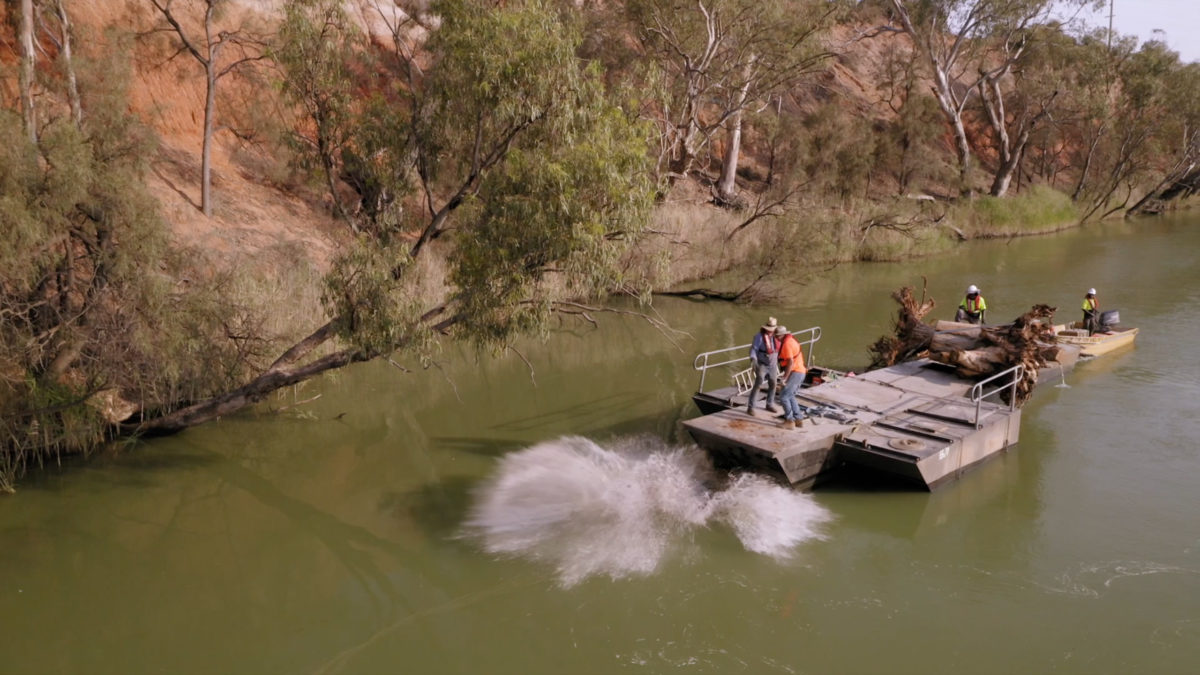Millions of snags have been deliberately removed in the past in large-scale desnagging operations. Unfortunately, they didn’t know at the time, but this was destroying the homes of our native fish.
Donate to OzFish today to improve fish habitat like this one.
More snags, more fish
Snags play such a major role in our native fish life cycle. Fish use snags to stop and rest from fast flows and as a place to breed and shelter. They also provide a great source of food, and with hundreds of thousands of snags removed over the years, mainly for boat navigation, re-snagging will prove to be a winner for fish and fishing.
Increased understanding of the importance of snags to native fish and river health has led to efforts such as this one which will help to reverse the loss of this vital fish habitat.
Recent research has indicated that native fish populations respond positively to sections of water bodies that have been re-snagged. A long-term study by scientists from the Arthur Rylah Institute found re-snagging, provided a threefold increase of native fish when a reach of the Murray River was re-snagged.
The new sites will promote the migration of native fish and greater survival of juvenile fish in the area.
Ongoing monitoring of the new habitat
In 2018 Sunraysia OzFish volunteer’s habitat mapped the stretch of the Murray River through modernized fish finders. The information, as well as consultation with the local community and agencies, were used to identify the most appropriate sites in need of restoration.
Over 180 hours were volunteered by Sunraysia OzFish members, to complete the habitat mapping along 14 km of the Murray River downstream of Red Cliffs and upstream of Mildura.
Consideration was then given to the type, size, shape and quantity of snags needed, as well as the position and orientation of each individual snag in the river. This level of detail is necessary to ensure that the structures are placed to maximise the benefits for native fish.
Educating the community
Community education has been fundamental to this project. Not only is OzFish activating recreational fishers to contribute to improving fish habitat but by educating the public, communities can learn more about our native fish and the benefits of re-snagging. Not only do they give back, but they also become better fishers in the process.
This newly restored site will be regularly monitored by the Sunraysia OzFish members to observe fish life around the structures and ensure they have settled into place correctly.
Frequently Asked Questions
-
What are snags?
Snags are trees, branches and root masses that are found in our rivers. Also known as large woody debris, snags result from trees on the river bank either falling in or dropping their branches. This can occur because of flooding, bank erosion, wind or limb shedding and is a natural process.
-
Why are snags important?
Snags provide extremely important habitat for our native fish and aquatic life. There are around 45 native fish species in the Murray–Darling Basin. Many of these species, such as Golden perch, River blackfish, Murray cod, and the critically endangered Trout cod, rely on snags. Snags provide fish with:
• sites to attach adhesive eggs during breeding;
• sites to rest from fast river flows;
• shelter from predators;
• landmarks to define territories and aid navigation;Some native fish even have preferences for certain types of snags and their location within the river. Trout cod, for example, have been shown to use snags closer to the middle of a river, whereas Murray cod use snags closer to the river bank.
Macroinvertebrates, an important food source for many native fish, use snags not only for shelter but also as food, grazing on the wood itself and the microbes and algae that grow on it.
Snags play an important role in shaping our rivers, creating variability in depth and flow. As a significant source of carbon, snags also contribute to the chemical composition of the water.
Join OzFish and be part of creating a sustainable fishing future
BECOME A MEMBER NOW
This project has been funded by the NSW Recreational Fishing Trust, Western Local Land Services and OzFish corporate partner BCF – Boating, Camping, Fishing
If you’d like to hear more about the project contact OzFish on 1800 431 308 or email info@ozfish.org.au.






